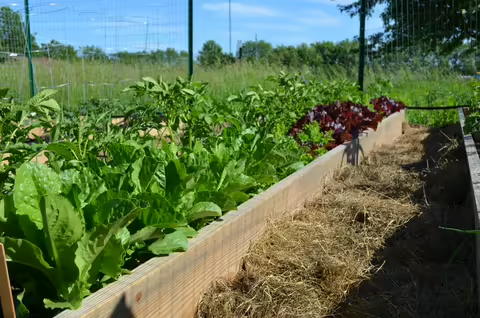URBANA, Ill. – Gardeners facing the aftermath of a hard winter often find themselves staring at problematic raised beds with significantly reduced soil levels.
“I remember building and then growing in my first raised bed,” says Chris Enroth, University of Illinois Extension horticulture educator. “Without a doubt, the plants grew exceptionally well. Root crops were a breeze and the weeds almost non-existent.”
But Enroth found changes after a successful growing season was followed by a standard Midwest winter, and, like most gardeners, discovered his once pristine growing space needed routine maintenance and care, particularly regarding soil.
“It is especially important to care for the soil in raised beds, and there are many methods of mixing soil and organic material to create that perfect raised bed fill,” says Enroth. “But even the best of gardeners will need to refresh the raised bed eventually. Settling soil is simply a fact of raised bed gardening.”
Annually, topdressing with a few inches of compost or high-quality topsoil into raised beds should be enough to keep up with the settling soil level, Enroth says. But occasionally a raised bed demands more significant attention to its soil structure.
Most raised beds are filled with some type of compost and topsoil mixture. For newly-built raised beds, there is little soil structure to this freshly installed fill material. This poor structure and frequent disturbance by the gardener causes raised bed soils to settle.
One way to help build structure is to sow cover crops in the offseason. That way roots consistently inhabit the raised bed soil, which helps to build the soil structure. While cover crops won’t halt raised beds from settling it will slow the process and build a vibrant medium for the garden to grow. Off-season cover crops are covered in depth at go.illinois.edu/OffSeasonCover.
Tilling has its place in gardening but can be overdone. Typically, Enroth recommends gardeners till new raised beds, if necessary, to mix the different fill components. Tilling can also be useful for gardeners who need to make some significant amendments in the future. However, avoid tilling the raised bed once it is established because it can destroy the developing soil structure of a raised bed and speed up the settling process.
While often raised beds start weed-free, over time weed seeds will find their way into the garden. Mulching the raised bed can be combined with topdressing to help suppress germinating weed seeds.
Mulch comes in a variety of forms. Typically, vegetables gardeners use mulch that can decompose, such as straw or arborist wood chips.
“Most gardeners realize that raised beds require maintenance,” says Enroth. “And while it may require getting out the wheelbarrow, the effort can be worth it for improved growing conditions, easier access, and more beautiful results.”
Illinois Extension features information on caring for soil at go.illinois.edu/GoodGardenSoil and a how-to on raised bed gardening at go.illinois.edu/HORTRaisedBeds.
SOURCE: Chris Enroth, Extension Educator, Illinois Extension
ABOUT EXTENSION: Illinois Extension leads public outreach for the University of Illinois by translating research into action plans that allow Illinois families, businesses, and communities to solve problems, make informed decisions, and adapt to changes and opportunities.
